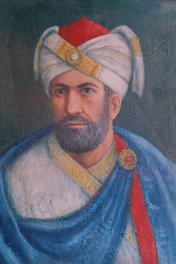Difference between revisions of "Abulfeda of Damascus (1273-1331)"
Tao alexis (talk | contribs) |
Tao alexis (talk | contribs) |
||
| (5 intermediate revisions by the same user not shown) | |||
| Line 1: | Line 1: | ||
[[File:Abulfeda.jpg|right|350px|thumb|]] | [[File:Abulfeda.jpg|right|350px|thumb|]] | ||
| − | '''Abulfeda of Damascus''' | + | '''Abulfeda of Damascus''' was a renowned historian and geographer, born in Damascus. His uncle served as the governor of Hamah, a city in Syria, and under his uncle's leadership, Abulfeda participated in significant campaigns against the Crusaders. Notably, he took part in the sieges of Tripoli and [[Akka]] in 1291, key events during the final decline of Crusader presence in the Levant. |
| − | + | In 1298, Abulfeda entered the service of the Mameluke Sultan al-Malik al-Nasir, under whom he gained considerable experience in both military and political affairs. By 1310, Abulfeda returned to Hamah as its governor. His loyalty and administrative skill earned him further recognition, and in 1312, he was granted the title of prince. This was followed in 1320 by his elevation to the title of sultan, cementing his status as a trusted and influential leader. | |
| − | [[Category: Historical Persons]][[Category: Writers]] | + | As a ruler, Abulfeda established prosperity in his domains, improving the infrastructure and constructing luxurious princely residences in Hamah. However, his enduring legacy lies in his contributions to literature and scholarship. He is best known for two monumental works. The first, ''Tarikh al-Mukhtasar fi Akhbar al-Bashar,'' is a comprehensive history of the Moslem world spanning the period from 622 to 1329. This work also delves into Arabic literature and culture, making it an invaluable resource for understanding the intellectual and social life of the era. The second, ''Taqwim al-Buldan,'' is a detailed geography of the most important regions of the Moslem world, offering rich descriptions of lands and cities. These works secured Abulfeda's reputation as one of the foremost scholars of his time, ensuring his influence extended far beyond his reign as a ruler. |
| + | |||
| + | |||
| + | [[Category: Historical Persons]][[Category: Writers]][[Category: Reviewed]] | ||
Latest revision as of 16:43, 28 January 2025
Abulfeda of Damascus was a renowned historian and geographer, born in Damascus. His uncle served as the governor of Hamah, a city in Syria, and under his uncle's leadership, Abulfeda participated in significant campaigns against the Crusaders. Notably, he took part in the sieges of Tripoli and Akka in 1291, key events during the final decline of Crusader presence in the Levant.
In 1298, Abulfeda entered the service of the Mameluke Sultan al-Malik al-Nasir, under whom he gained considerable experience in both military and political affairs. By 1310, Abulfeda returned to Hamah as its governor. His loyalty and administrative skill earned him further recognition, and in 1312, he was granted the title of prince. This was followed in 1320 by his elevation to the title of sultan, cementing his status as a trusted and influential leader.
As a ruler, Abulfeda established prosperity in his domains, improving the infrastructure and constructing luxurious princely residences in Hamah. However, his enduring legacy lies in his contributions to literature and scholarship. He is best known for two monumental works. The first, Tarikh al-Mukhtasar fi Akhbar al-Bashar, is a comprehensive history of the Moslem world spanning the period from 622 to 1329. This work also delves into Arabic literature and culture, making it an invaluable resource for understanding the intellectual and social life of the era. The second, Taqwim al-Buldan, is a detailed geography of the most important regions of the Moslem world, offering rich descriptions of lands and cities. These works secured Abulfeda's reputation as one of the foremost scholars of his time, ensuring his influence extended far beyond his reign as a ruler.
